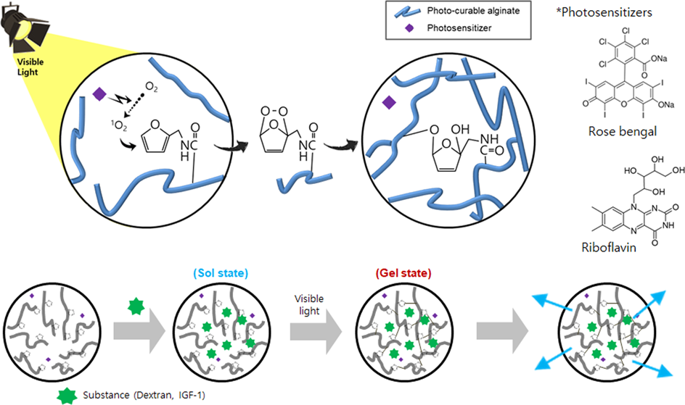Our official English website, www.x-mol.net, welcomes your
feedback! (Note: you will need to create a separate account there.)
Gelation and release behavior of visible light-curable alginate
Polymer Journal ( IF 2.3 ) Pub Date : 2019-10-30 , DOI: 10.1038/s41428-019-0280-6 Yun Heo , Jun Akimoto , Eiry Kobatake , Yoshihiro Ito
Polymer Journal ( IF 2.3 ) Pub Date : 2019-10-30 , DOI: 10.1038/s41428-019-0280-6 Yun Heo , Jun Akimoto , Eiry Kobatake , Yoshihiro Ito

|
Visible light-curable alginate was prepared by coupling alginate with furfurylamine. The furan content of the alginate was investigated through Fourier transform infrared spectroscopy and proton nuclear magnetic resonance spectroscopy. The prepared furfuryl alginate (F-Alginate) underwent gelation in the presence of a photosensitizer, such as Rose Bengal or riboflavin, under visible light irradiation. The time course of this gelation was similar to that of conventional Ca 2+ -induced gelation. When the formed gel was assessed using a rheometer, it was found that F-Alginate has a high storage modulus G′ comparable with that of a Ca 2+ -cross-linked gel. It was possible to encapsulate substances in the gel through simple mixing. The release rate of encapsulated substances depended on their molecular weight. As the molecular weight of encapsulated dextran increased, slower release was observed. These release behaviors are comparable with those of a Ca 2+ -cross-linked gel. The release rate of a growth factor protein was the same as that of dextran with the same molecular weight. Cell growth was enhanced in response to a sustained release of insulin-like growth factor-1 from the F-Alginate hydrogel. Visible light-curable alginate was prepared by coupling alginate with furfurylamine. The prepared furfuryl alginate (F-Alginate) underwent gelation in the presence of a photosensitizer under visible light irradiation. The mechanical and release properties of the visible light-induced gel were similar to that of conventional Ca 2+ -induced cross-linked alginate. The release rate of encapsulated substances depended on their molecular weight. Cell growth was enhanced in response to a sustained release of insulin-like growth factor-1 from the F-Alginate hydrogel.
中文翻译:

可见光固化海藻酸盐的凝胶化和释放行为
通过将海藻酸盐与糠胺偶联制备可见光固化海藻酸盐。通过傅里叶变换红外光谱和质子核磁共振光谱研究藻酸盐的呋喃含量。在可见光照射下,在光敏剂(如玫瑰红或核黄素)的存在下,制备的海藻酸糠酯(F-海藻酸盐)发生凝胶化。这种凝胶化的时间过程与传统的 Ca 2+ 诱导的凝胶化的时间过程相似。当使用流变仪评估形成的凝胶时,发现 F-海藻酸盐具有与 Ca 2+ 交联凝胶相当的高储能模量 G'。可以通过简单的混合将物质封装在凝胶中。包封物质的释放速率取决于它们的分子量。随着包封的葡聚糖的分子量增加,观察到较慢的释放。这些释放行为与Ca 2+ 交联凝胶的释放行为相当。生长因子蛋白的释放速率与相同分子量的葡聚糖的释放速率相同。响应于 F-藻酸盐水凝胶中胰岛素样生长因子-1 的持续释放,细胞生长得到增强。通过将海藻酸盐与糠胺偶联制备可见光固化海藻酸盐。制备的海藻酸糠酯(F-海藻酸盐)在可见光照射下在光敏剂存在下发生凝胶化。可见光诱导凝胶的机械和释放特性与常规Ca 2+ 诱导的交联海藻酸盐相似。包封物质的释放速率取决于它们的分子量。
更新日期:2019-10-30
中文翻译:

可见光固化海藻酸盐的凝胶化和释放行为
通过将海藻酸盐与糠胺偶联制备可见光固化海藻酸盐。通过傅里叶变换红外光谱和质子核磁共振光谱研究藻酸盐的呋喃含量。在可见光照射下,在光敏剂(如玫瑰红或核黄素)的存在下,制备的海藻酸糠酯(F-海藻酸盐)发生凝胶化。这种凝胶化的时间过程与传统的 Ca 2+ 诱导的凝胶化的时间过程相似。当使用流变仪评估形成的凝胶时,发现 F-海藻酸盐具有与 Ca 2+ 交联凝胶相当的高储能模量 G'。可以通过简单的混合将物质封装在凝胶中。包封物质的释放速率取决于它们的分子量。随着包封的葡聚糖的分子量增加,观察到较慢的释放。这些释放行为与Ca 2+ 交联凝胶的释放行为相当。生长因子蛋白的释放速率与相同分子量的葡聚糖的释放速率相同。响应于 F-藻酸盐水凝胶中胰岛素样生长因子-1 的持续释放,细胞生长得到增强。通过将海藻酸盐与糠胺偶联制备可见光固化海藻酸盐。制备的海藻酸糠酯(F-海藻酸盐)在可见光照射下在光敏剂存在下发生凝胶化。可见光诱导凝胶的机械和释放特性与常规Ca 2+ 诱导的交联海藻酸盐相似。包封物质的释放速率取决于它们的分子量。











































 京公网安备 11010802027423号
京公网安备 11010802027423号